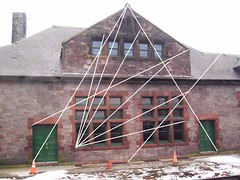nitty gritty
i'm working on the nitty gritty of the shed frame. i'm trying to figure out the structure, looking at the joints, timber sizes, spans. the shed roof presents some difficulty with a need to span 28 feet over the dining room. i doubt we're going to be able to find 28 foot timbers, but i will check into it. we could just go into the forest and take down a few trees, bark them and put them up round. it would be impressive, but very heavy! other options are to put in middle posts and i've come across a couple of heavy timber flat-roof trusses that would work but i don't know that a truss overhead in the dining room is the look or feel we want.
i'm also looking at how the straw will interface with the frame. it seems to make the most sense to me to place the straw outside the frame. this means that we have to have four foot overhangs (2 feet over the straw itself and another 2 feet to keep drips off the straw). we may be able to use extensions from the frame with braces, as in the drawings below that show the overhang supported by braces. this would limit the length of the spanning beams to the frame width. in the case of the kitchen this would be 14 feet, which is workable.
this saturday there will be a design meeting in my studio at the tip top building. we'll be going over all this stuff! 3pm.























